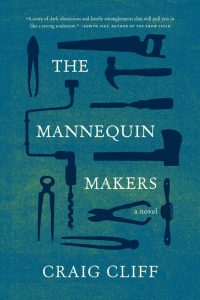Book Review
 Writing a novel often feels like conducting an extended thought experiment. If your wife died in childbirth, the novelist asks, how would that affect your relationship with your newborns? If you sheltered your children and taught them that the only way to ensure a respectable marriage was to spend one’s entire childhood and adolescence honing a particular skill—say, the ability to pose motionless in a department store window like a living mannequin—would they later be able to form healthy relationships with people (or, for that matter, each other)? In his debut novel, The Mannequin Makers, New Zealander Craig Cliff asks these uncomfortable questions in service of a larger goal: to uncover via thought experiment the true nature and the hidden tortures of beauty (and the pursuit thereof).
Writing a novel often feels like conducting an extended thought experiment. If your wife died in childbirth, the novelist asks, how would that affect your relationship with your newborns? If you sheltered your children and taught them that the only way to ensure a respectable marriage was to spend one’s entire childhood and adolescence honing a particular skill—say, the ability to pose motionless in a department store window like a living mannequin—would they later be able to form healthy relationships with people (or, for that matter, each other)? In his debut novel, The Mannequin Makers, New Zealander Craig Cliff asks these uncomfortable questions in service of a larger goal: to uncover via thought experiment the true nature and the hidden tortures of beauty (and the pursuit thereof).
At the heart of Cliff’s novel is Avis Kemp, one of the aforementioned living mannequins. She and her twin brother Eugen are trained from birth by their father, Colton, a department store window-dresser in early twentieth-century Marumaru, New Zealand, to control every muscle of their bodies, including those that control blinking. He draws inspiration from a strongman named Sandow who visits small town Marumaru by accident on his way to another engagement. During Sandow’s performance, Colton is struck by the famed strongman’s mastery of his own body and, at the same time, disappointed in the failure of Sandow’s fellow performers (actresses pretending to be Greek statues) to refrain from blinking on stage. And so the great idea is born. But Colton’s true motivations are much deeper and darker. His failure as a sculptor and his rivalry with fellow window-dresser The Carpenter—whose hand-carved mannequins consistently outshine Colton’s mechanical installations—drive Colton to extremes. He tries to satisfy his professional ambition while at the same time honoring his late wife, whose skill as an artist (she was the one who drew the designs for Colton’s window displays) humbled him. He intends to attain her level of artistry and one day surpass it by turning their children into living, breathing—but not blinking—works of art.
In reading The Mannequin Makers, I was reminded of Yorgos Lanthimos’s film Dogtooth, which conducts a similar thought experiment. In the critically acclaimed film, three teenagers are raised inside of a fenced compound by parents who (for reasons not fully explained) isolate them from the rest of the world and teach them the wrong words for things. A flower, for instance, is a “zombie,” and a vagina becomes a “keyboard” in their household parlance. Cut off from the real world, the teenagers learn little of society, and what they do glean distorts their understanding of human interaction; so too does the experience of being raised to be living mannequins distort the perceptions of Avis and Eugen. Taught that outer beauty and physical perfection are the means to prosperous marriages and successful careers, the siblings naturally become superficial, obsessed with their own bodies and enamored of each other’s. It should come as no surprise, after the long days spent posing as lovers, that the twins become lovers and spend nights exploring their young, perfect bodies. Whereas the parents in Dogtooth treat sex as perfunctory, something to be bought and paid for so their son can achieve release on a regular basis, Colton Kemp doesn’t address this issue at all. Certainly he doesn’t teach his children about the dangers of incest. One wonders if he even bothers to speak to Avis about becoming a woman. This could explain how long it takes for her to realize that she’s pregnant with Eugen’s child.
Colton Kemp’s failures as a father, however, are Cliff’s successes as a novelist. Although the subjects of his thought experiment meet a tragic end, the results are remarkable. Readers finish the novel having learned that beauty invariably comes at a price: physical and psychological, personal and professional. It destroys everyone who seeks it. At the end of the novel, Eugen, now an old man, states, “This is my shape. This is who I am,” therein conflating his body with his self. It’s a testament to Cliff’s skill as a writer that the reader can leave this novel simultaneously feeling wonder and revulsion at the human form, particularly one as perfect as Eugen Kemp’s. As disturbing as it is engaging, Cliff’s The Mannequin Makers is a formally ambitious exploration of beauty and its horrors.
About the Reviewer
Ruth Joffre is the author of the story collection Night Beast. Her writing has appeared in Kenyon Review, Hayden's Ferry Review, Mid-American Review, Prairie Schooner, Nashville Review, and Copper Nickel. She is currently at work on a novel.